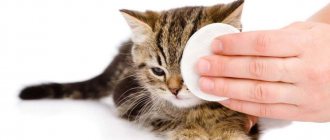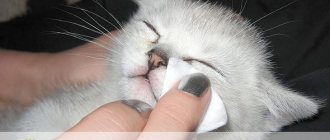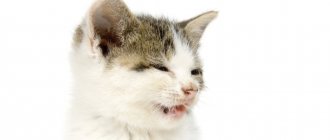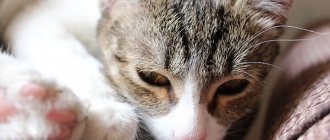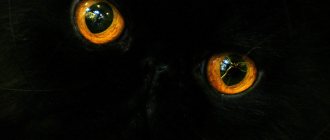Often, cat owners have the following problem: watery discharge begins to appear from the eyes or one eye of the animal, but do not panic prematurely. There are many reasons for watery eyes, and it is not necessarily a serious illness.
Before examining your pet, you should wash your hands and carefully examine the condition of the eye. It may be possible to make a diagnosis without resorting to the services of a veterinarian. So, one of the cat’s eyes is watering, what to do, how to cure it?
The animal's eyes are watery: reasons
Tearing can occur either from natural causes or as a result of illness.
In the first case, tears from the eyes may appear:
- After the furry animal woke up. This is a normal reaction of the body. The cat removes traces of tears itself by washing its face. For kittens, you can wash their eyesight with a swab moistened with boiled water.
- If the cat belongs to a certain breed. The Persian, the British, the Sphinx have tears and a peculiarity of the body. Persians are too fluffy, and doctors often diagnose the Sphynx breed with a disease called “entropion.” In this case, the animal can only be cured by resorting to surgery.
- If hair fibers get on the cornea. This symptom often occurs in long-haired small carnivores. The only thing that will help your cat is regular eye care.
In the second case, the cat may cry due to:
- Mechanical damage, injuries. A pet can damage the eyelid, eye, or cornea in a confrontation with another representative of its breed, during play or a walk. A sharp blade of grass or a twig that scratches the organ of vision can cause serious inflammation.
- Foreign objects. A small speck, a piece of tree bark, or a piece of plastic is enough to cause an inflammatory process to develop in a cat’s eye. Treatment in this case includes procedures for treating with solutions of antibacterial drugs.
- Burn. Curious animals often stick their noses into everything they find at home. Aggressive household chemicals, solvents, and wood varnish can become an object of curiosity, which will lead to a chemical burn. A pet can get a thermal burn if it becomes interested in cooking in the kitchen.
- Allergic reaction. Allergies are the scourge of the modern world; not only people, but also animals are susceptible to manifestations of allergies to various irritants.
- Incorrect eyelash growth. Sometimes a cat has a pathology - the eyelashes grow incorrectly, causing the pet a lot of suffering: the eyelid is inflamed, tears constantly ooze. In this case, the help of a veterinarian is required.
- Helminth infections. One of the signs of the disease is increased production of tears.
- Conjunctivitis. The infection is caused by chlamydia; only a veterinarian can cure the little predator.
- Colds. A cat often cries if it has a cold.
Be sure to read:
A cat refuses to eat: reasons, why it’s dangerous, first aid, what to do, how to increase the animal’s appetite
Symptoms of the condition
The reasons that caused this process, as well as the level of complexity of the disease itself, affect the severity of lacrimation:
- the animal's eyes are slightly swollen, and this is accompanied by slight lacrimation,
- if the process continues for quite a long time, then hair loss occurs in the eye area and this causes eczema or dermatitis,
- discharge can change its thickness - from liquid to viscous,
- the appearance of dried particles in the corners of the eyes,
- the occurrence of itching, in which the animal rubs the eyes even more and injures them,
- the conjunctiva turns red and swells,
- When the disease is advanced, the animal develops a fever, depression and even a fear of light.
Next, we will look at the reasons why the eyes of kittens and cats of certain breeds become watery.
The answer to this question is quite simple: kittens have a rather weak immune system and their body is not able to adequately resist various infectious agents.
READ How long do guppies live in an aquarium?
The lack of timely vaccinations only exacerbates this process. In addition, worms (helminths) in the kitten's intestines can cause the release of tear fluid or even suppuration in the eye area. That is why kitten eye hygiene should become a daily concern for any owner.
A healthy animal's eyes should always be clean. If this is not the case, then you urgently need to vaccinate the kitten and expel the worms from its body.
Scottish Folds have watery eyes, mainly because the shape of the Scottish Fold's muzzle is very flattened, and this is why they have narrow tear ducts. Scots also sometimes suffer from entropion of the eyelids, and this is also one of the causes of lacrimation.
British cats, like Scottish cats, have a special skull structure and this negatively affects the length of the nasolacrimal ducts.
Persian cats also have weak nasolacrimal ducts.
Sphinxes quite often have their eyelids turned upside down and this causes them to suffer from lacrimation.
To distinguish physiology from pathology, the owner needs to know a number of clinical signs indicating that the pet has health problems. The most characteristic symptoms are:
- Lack of appetite in the animal, lethargy and general malaise.
- An increase in both general and local temperatures.
- Redness, swelling of the eyelids and conjunctiva of one or both eyes.
- There may be severe itching in the eyelid area.
- Profuse lacrimation.
- The presence of purulent exudate (discharge), which dries and subsequently forms crusts around the sore eye.
- Hair loss in the eyelid and nose area.
A cat's eye is watering: what to do?
Excessive production of tears from one eye requires immediate action on the part of the owner:
- Assessment of general condition. It is necessary to conduct a visual inspection, measure body temperature, and examine the cat for injuries.
- Treatment of the affected eye with furatsilin (solution), decoctions of medicinal herbs.
- A trip to the veterinary clinic.
During treatment, a number of rules should be followed:
- Rinse both healthy and affected organs of vision.
- Remove the allergen from the home if an allergic reaction is diagnosed.
- When treating an infection, lubricate the eyes with ointments 2 times a day.
- If surgery is required, do not remove the special collar from the cat until complete healing.
First aid and subsequent treatment
Quite often, after determining the reasons for the appearance of tears in a cat, its owners do not have enough time or funds to provide assistance to their pet in a veterinary clinic. In this case, such assistance can be provided to the animal at home. It is generally accepted that any antiseptic solutions are suitable for this. Furacilin is used as a 0.2% agent.
If the cause of conjunctivitis is a bacteria, then the following will be useful:
- sofradex,
- chloramphenicol or
- kanamycin.
Any of these drugs are instilled into the animal 5 times a day, 2-3 drops in each eye.
If you have an ointment that contains antibiotics (tetracycline ointment is the most popular), it should be applied three times a day.
If there is significant swelling in the eye area, the cat suffers from pain, and here novocaine or hydrocortisone will help.
If the cause of lacrimation is a foreign body in the eye, then anesthesia with an injection is required to remove the foreign object. When the pain subsides a little and the animal calms down, you need to take tweezers, a cotton swab, roll the eyelid outward and try to extract the cause of the lacrimation.
Among the folk remedies, a decoction of chamomile, St. John's wort, calendula or sage is used to wash the sore eyes of cats with lacrimation. Also, lotions with infused black tea are quite effective.
READ Why is the water in the aquarium cloudy and what to do about it?
Quite often, health problems arise in pets away from home, for example, in the country, where you can’t always find a human doctor, let alone a veterinarian. In such situations, the owner has to decide what to do if a cat’s eye is watery. If the disease is not very serious, then the owner will be able to help the pet. First of all, you need to examine the victim and understand the cause of the ailment. Having eliminated it, you should provide your pet with complete rest.
Having created the necessary conditions for the animal, you can begin treatment. For example, with purulent conjunctivitis, it is often enough to wash the eyes twice a day with decoctions of medicinal herbs (calendula, sage, chamomile, St. John's wort) prepared at home. Also, brewing black tea or a weak solution of potassium permanganate is perfect for these purposes.
You need to remember that both eyes need to be treated, even if only one hurts. First, the healthy one is washed, and then the sick one.
Eye drops and ointments, the active ingredient of which is an antibiotic, are well suited for the treatment of inflammation. Such drugs include:
- Sulfacyl sodium;
- Levomycetin;
- Tetracycline eye ointment.
Treatment with one of these drugs should be started immediately after the first symptoms of the disease appear. Ointment and drops are prescribed in both eyes three to four times a day.
If redness of the eyes and watery eyes are caused by an allergic reaction, then it is necessary to stop the animal’s contact with the irritant (refuse new food and return to the old and proven diet, remove all cleaning and detergents, change the cat litter, etc.
In other cases, it is best not to self-medicate, but to seek help from a veterinarian. The doctor will make the correct diagnosis, provide first aid, prescribe the correct treatment, and, if necessary, perform surgery. You should not be afraid of surgical intervention, as there are pathologies that can only be eliminated with a scalpel, these include trichiasis and entropion. After all the necessary procedures, the owner will receive his pet back safe and sound.
How to wash your eyes at home?
In some cases, such as if a foreign body, irritant, or injury gets into the eye, it is necessary to rinse your cat's eyes at home before going to the clinic. A sterile saline solution is best suited for this; it is sold in pharmacies, but you can also use cool boiled or even running tap water.
Soak a cotton ball or pad generously with water and apply it to the eye, then, moving from the inner corner of the eye to the outer corner, remove any discharge. Change cotton pads as often as possible; use a separate cotton ball or pad for each eye. For a generous rinse, you can lightly squeeze water from a cotton ball directly into your cat's eye. It is possible that this procedure may require an assistant to secure the cat in a comfortable position for this procedure.
Do not use drops or other medications until examined by a doctor. And remember that washing your eyes at home does not replace treatment and is a first aid measure.
Sources:
https://www.royalcanin.com/ru/cats/health-and-wellbeing/discharge-from-eyes
https://petstory.ru/knowledge/cats/cat-health/cat-prevention/u-koshki-slezyatsya-glaza-chto-delat/
https://vetonline.pro/ru/blog/pochemu-u-kota-slezyatsya-glaza.html
Causes
The culprits of lacrimation in cats are the following:
recommended articles:
- Why does a cat squint one eye?
- Changes in eye color in cats
- Viral or bacterial infection. Most often, the visual organs are affected by the following diseases:
- Rhinotracheitis.
- Calcivirosis.
- Panleukopenia.
- Chlamydia.
- Invasion by unicellular parasites.
- Infection with helminths.
- Allergies in cats. A hypersensitive reaction occurs to many stimuli.
- Mechanical injuries.
- Keratitis.
- Age. Tearfulness is observed in kittens in the first month of life.
- Features of some breeds. Sphinxes and rexes develop entropion of the eyelids. The anatomical uniqueness of the structure of the skull of British or Persian animals determines their predisposition to tearfulness.
Inversion of the eyelid
Under certain circumstances, only one eye of a cat becomes watery. The following causes of pathology are distinguished:
- Injury. The animal scratched its eye on its own or in a fight with another, got hit by a speck, splashed a toxic substance, etc.
- Chlamydia. The infection first affects one eye and after some time can spread to another organ. Most often, kittens older than a month are affected. In adults, the disease is asymptomatic, worsening when the immune system is weakened as a result of helminthic infestations.
Chlamydia
Prevention
Preventive measures come down to the following actions:
- Follow sanitary rules for keeping cats.
- Block access to allergens.
- Be careful when giving your pet treats.
- Carry out pest control and deworming regularly.
- Vaccinate animals. Among the vaccines that can protect against panleukopenia, calcivirosis, chlamydia and rhinotracheitis, the following are most in demand: Multifel-4, Leucorifellin, Vitafelvac.
We invite you to join our Zen channel and group on VKontakte or Odnoklassniki, where new articles for pet owners are published.
Similar articles:
- My cat has a nosebleed - what should I do?
- Inflammation of the lower lip in a cat
- Clear nasal discharge in cats
Treatment and prevention
Treatment should be prescribed by a veterinarian after an accurate diagnosis has been made. A trip to the veterinarian or calling a specialist to your home is the first thing the owner should do. The veterinarian will want to know when deworming was carried out, vaccinations, the cat’s diet, how and when lacrimation appeared, what preceded it - be prepared to answer these questions.
Treatment
For treatment, drops from veterinary and regular pharmacies, antibiotic ointments and eye films are most often used.
If lacrimation has become a pathology, then veterinarians most often prescribe instillations for bacterial conjunctivitis:
- Levomycetin - antimicrobial drops with rapid local action. The antibiotic is sold in a regular pharmacy. It is inexpensive: a bottle of 5 ml. 6 rubles (9 UAH);
- Kanamycin is a medicine for bacterial diseases. The antibiotic can be purchased in pharmacies for 12 rubles. (13 UAH);
- Sulfacyl sodium – transparent eye drops for the treatment of people. Approved for use in cats for eye diseases. The antimicrobial drug is sold in regular pharmacies - a bottle costs 27 rubles. (16 UAH);
- Sofradex is an antibiotic with anti-inflammatory and antiallergic effects. Prescribed for superficial eye infections, allergic conjunctivitis. In Russia the bottle is 5 ml. Costs 326 rubles, in Ukraine – 64 UAH.
Allergic tearing, as we have already written, goes away after the end of the hormonal course of treatment.
But only a specialist will tell you what to do in case of a viral infection and how to treat it!
How to properly instill eye drops
All therapeutic procedures should be carried out in a calm, natural environment. Stroke, caress the cat, talk to it in a gentle and calm voice.
If you are not sure that you can handle the animal on your own, call someone for help - let the assistant hold the cat in his arms during the procedure. Overly aggressive animals can be pre-wrapped in a terry towel.
Your next steps:
- Soak a cotton pad in warm water and wash your cat's eyes. Rinsing is a mandatory step before each instillation.
- Take the bottle of medicine in your right hand, and with your left hand pull the eyelid down.
- Place the required number of drops into the resulting gap.
- Make sure that the medicine gets into the eye and not onto the animal's fur.
- After instillation, hold your pet tightly; at this time, he feels itching and burning. It is necessary to hold it so that the cat does not scratch the itchy eye with its paw.
- Be sure to praise and pet the cat after all manipulations. Give your pet his favorite treat.
Important!
For local therapy, in addition to drops, eye ointments with an antibacterial effect can be prescribed: “Levomycetin”, “Tetracycline”. They need to be placed behind the third eyelid.
Prevention
To prevent your kitten's eyes from watering, follow these rules:
- No drafts.
- Do not let your cat become hypothermic.
- Follow the vaccination schedule and strengthen the animal's immunity.
- Don't ignore preventive visits to the veterinarian.
- Carry out anti-parasitic measures regularly.
- Monitor the condition of your pet's eyes.
- Choose your diet wisely.
- Do not allow your pet to come into contact with poisonous or toxic substances. Keep household chemicals out of reach.
- Brush your cat carefully to keep hair out of your eyes.
- Avoid touching your cat's eyes with dirty hands.
- Do not allow the mustache to come into contact with homeless and sick relatives.
- Keep your home clean.
Eye washes and drops can be used for prevention in kittens and adult animals.
What to do for prevention?
To ensure that the cat no longer has problems with inflammation and tearing of the eyes, it is important for the owner to monitor the cleanliness of the mucous membrane. To do this, it is recommended to wipe your eyelids with a cotton pad soaked in chamomile infusion as they become dirty. In addition, do not forget about preventive deworming, timely vaccination, and strengthening the body’s protective functions. If lacrimation is profuse and first aid does not bring results, it is risky to hope that the situation will resolve on its own. You need to visit the veterinarian as soon as possible, find out the diagnosis and start therapy.
Diagnosis
Take the time to contact your veterinarian if the following symptoms occur:
- watery eyes turned red;
- eyelids are swollen;
- the kitten is lethargic and refuses to eat;
- pus is discharged profusely;
- the fur around the eyes has changed color, eyelashes are falling out;
- the pet is afraid of light;
- the lens has become white or covered with a film;
- The eye is always in a half-closed state.
Experts distinguish between pathologies of the eyelids, mucous membrane, and the eyeball itself; eyelid and eye injuries. Lacrimation also occurs with common diseases.
| Pathology | Symptoms |
| Eye diseases | |
| Blepharitis (inflammation of the eyelid) | In the simple form, there is hyperemia and thickening of the eyelid, keratinized gray-white pieces of skin near the eyelash line. With ulcerative – the edges of the eyelids swell; the eyelids are covered with pus, under which ulcers are hidden. In any form, tears flow, the cat scratches its eyes, and sometimes eyelashes fall out. |
| Inversion / inversion of eyelids | Watery eyes, uncontrolled closing of the eyelids; clouding or redness of the lens, ulcers on the cornea. |
| Acute catarrhal conjunctivitis (inflammation of the conjunctiva; a common explanation for why one eye is watering in a cat) | The cat squints, the discharge from the eyes is serous-mucous, the lens is red, the conjunctiva is swollen. |
| Chronic catarrhal conjunctivitis | The conjunctiva is dry, red, and may turn blue; discharge is thick, gray-white |
| Purulent conjunctivitis | The eyelids are swollen and hot; Yellow-white pus is released from the cat's eyes; the conjunctiva turns red and swells. |
| Follicular conjunctivitis | The follicles on the inner surface of the third eyelid become inflamed and enlarged, causing the eyeballs to become constantly irritated. |
| Corneal injuries | The eyes are watering, the cat is afraid of the light. When viewed under side lighting, a wound with blood vessels is visible. |
| Keratitis (inflammation of the cornea) | The eyes are cloudy and lack shine. The discharge is gray-white or yellow. |
| General diseases | |
| Allergy | After contact with the allergen, the cat sneezes and the eyes become watery, the eyelids become red and swollen. The discharge is watery and colorless. Symptoms appear periodically (most often in the spring). |
| Respiratory tract infection | The eyes are watery and snotty, the cat is coughing, and the temperature rises. |
Tearfulness is a symptom of many bacterial, viral and fungal diseases (toxoplasmosis, chlamydia, mycoplasmosis, etc.). A diagnosis can only be made after testing. And for this you need to go to a veterinary clinic.
